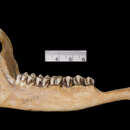Biology
(
الإنجليزية
)
المقدمة من Arkive
Duikers are shy animals that move around alone or in pairs (3). Like other duikers, pairs of black-fronted duikers inhabit a territory that is marked with scented secretions from glands on the face (2). Within this area of habitat, the duiker follows regular paths from its sleeping shelter to feeding grounds (2), where it consumes a variety of fruit and succulent vegetation (2). Information on the life history of the black-fronted duiker is lacking, but an individual in captivity lived for nearly 20 years (3).
Conservation
(
الإنجليزية
)
المقدمة من Arkive
The black-fronted duiker occurs in numerous protected areas throughout its range, including Lake Lobeke Reserve, Cameroon; Virunga National Park, Democratic Republic of Congo; and Ipassa Reserve, Congo (5), which will hopefully help protect this wary antelope from detrimental human activities.
Description
(
الإنجليزية
)
المقدمة من Arkive
The black-fronted duiker is a sturdy and active antelope (3), named for the broad black streak that runs from the nose to its forehead (2), which distinguishes this species from the other duikers of Africa (4). Its glossy coat is a shade of red, chestnut, or dark red-brown (2) (4), with the hair becoming thinner and darker, almost black, on the long legs (2). The short tail is black with a white tip (4). Both male and female black-fronted duikers have short, pointed horns (3), measuring between 4 and 12 centimetres (4), which are used in combat with other duikers and in defence against predators (3). The subspecies Cephalophus nigrifrons rubidus (the Ruwenzori black-fronted duiker), which is recognised by some as a distinct species, differs in appearance by having a white belly and thicker hair (4).
Habitat
(
الإنجليزية
)
المقدمة من Arkive
This small antelope is an inhabitant of montane, lowland, and swamp forests (2) (4), from low altitudes up to 3,500 metres above sea level (2).
Range
(
الإنجليزية
)
المقدمة من Arkive
The black-fronted duiker occurs in central Africa, from southern Cameroon to western Kenya and northern Angola (3). The Ruwenzori black-fronted duiker occurs only in the Ruwenzori Mountains, a mountain range located on the border between Uganda and the Democratic Republic of Congo (4)
Status
(
الإنجليزية
)
المقدمة من Arkive
Classified as Lower Risk / Near Threatened (LR/nt) on the IUCN Red List 2007 (1). Subspecies: Cephalophus nigrifrons rubidus (Ruwenzori black-fronted duiker) is classified as Endangered (EN) on the IUCN Red List 2007 (1).
Threats
(
الإنجليزية
)
المقدمة من Arkive
Like other duikers, the black-fronted duiker is being impacted by both hunting for food and habitat destruction (3) (4). As human populations in some parts of central Africa rapidly expand, duikers are increasingly hunted and suitable habitat is lost to human settlements and agriculture (1) (3).
Black-fronted duiker
(
الإنجليزية
)
المقدمة من wikipedia EN
The black-fronted duiker (Cephalophus nigrifrons) is a small antelope found in central and west-central Africa.
Description
The black-fronted duiker is a compact, short-necked, and active antelope that gets its name from the broad black streak that runs from the nose to its forehead, a feature distinguishing it from its congeners. It has a glossy coat that is deep reddish-mahogany to a lighter orange-chestnut in colour, the hair becoming sparser and darker on the long legs. It has a short tail that is black with a white tip and short, pointed horns, measuring 4–12 cm, which are carried by both sexes and are used for defense against other duikers and predators. Their elongated hooves appear to be an adaptation to the wet habitats they seem to prefer. It weighs 14–18 kg (31–40 lb) and has a shoulder height of 43 cm (17 in).[2]
Distribution
The black-fronted duiker is found in central and west-central Africa, with an isolated population in the Niger Delta in eastern Nigeria and then from southern Cameroon east to western Kenya and south to northern Angola.[1]
Habitat
The black-fronted duiker occurs in montane, lowland, and swamp forests, from near sea level up to an altitude of 3,500 metres. It is frequently recorded in wetter areas such as marshes or on the margins of rivers or streams.[2]
Habits
The black-fronted duiker is territorial and monogamous, each pair owning a territory that it defends against neighbours and is marked using the secretions of the facial glands. The pair have habitual paths within their territory that connect sleeping sites with feeding areas and allow them to be active during both day and night. They are mainly browsers but will also feed on fruit.[2]
Subspecies
The currently recognised subspecies are:[3]
-
Cephalophus nigrifrons fosteri St. Leger, 1934
-
Cephalophus nigrifrons hooki St. Leger, 1934
-
Cephalophus nigrifrons hypoxanthus Grubb and Groves, 2002
-
Cephalophus nigrifrons kivuensis Lönnberg, 1919
-
Cephalophus nigrifrons nigrifrons Gray, 1871 .
-
Cephalophus nigrifrons rubidus Thomas, 1901: Ruwenzori duiker
References

Black-fronted duiker: Brief Summary
(
الإنجليزية
)
المقدمة من wikipedia EN
The black-fronted duiker (Cephalophus nigrifrons) is a small antelope found in central and west-central Africa.

